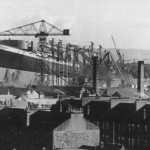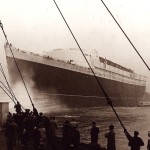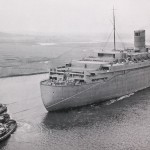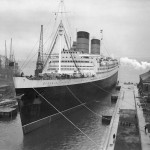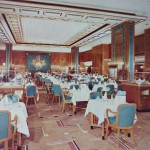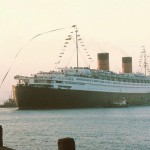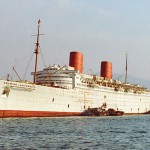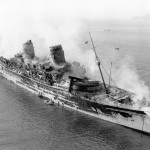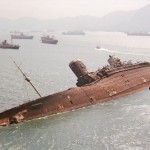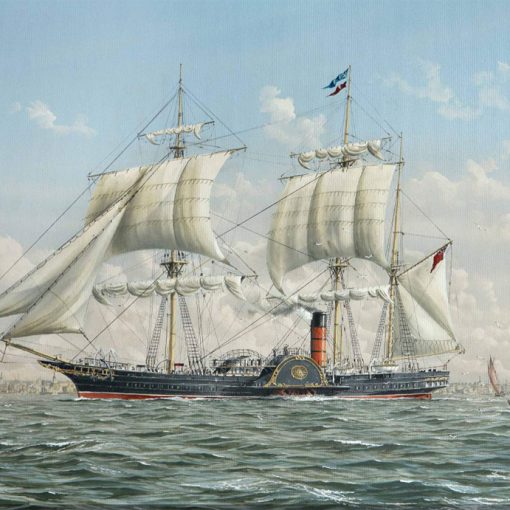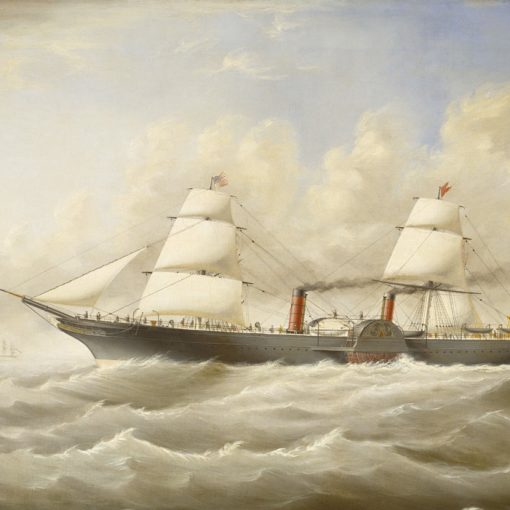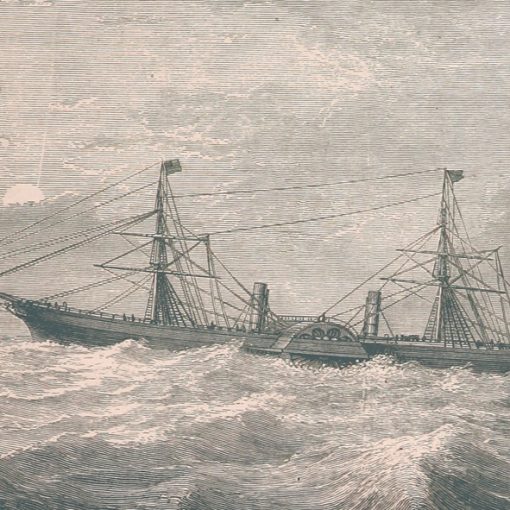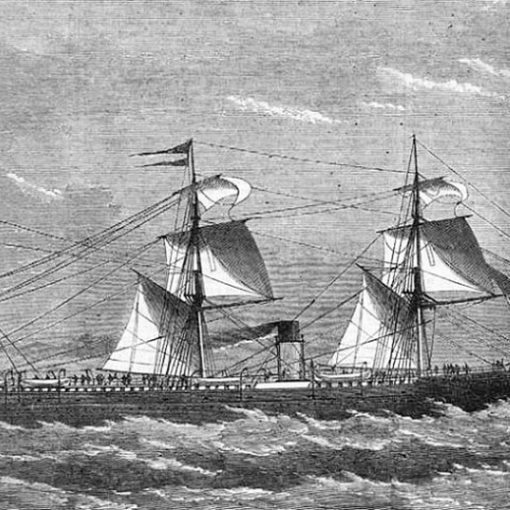1940 – 1973
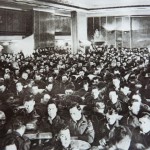
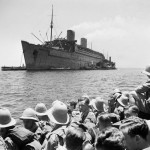
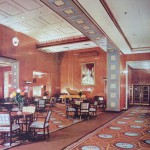
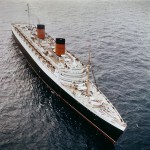
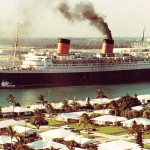

The closing years of the 1920s and the following first of the 1930s were to become the time in which some of the greatest passenger vessels ever built came to life. The years following the First World War had not seen much development in naval design – at least not in the matters of size and speed. The first shipping company who sought out to change this was the White Star Line, which had ordered their third Oceanic from Harland & Wolff. That ship was intended to be the first ever to exceed a thousand feet in length, but the company’s already strained financial situation was worsened when The Great Crash struck. The order of the Oceanic was cancelled, and the unfinished hull was broken up and turned into the 26,000-ton Britannic who was introduced in 1930.
The French Line, which was planning their new champion – the Normandie – was not immediately affected by the crash, and could continue with the construction. Launched in 1932, the Normandie set out on her maiden voyage in 1935 and proved to be the very latest in ship technology. But the Cunard Line had not been resting to deal with this competition. The keel of their own supership had been laid in December 1930, but the construction was brought to a halt a year later due to the poor economic situation. Unlike the White Star’s Oceanic however, the uncompleted ship was not broken up. Cunard had hopes of continuing the work soon, but it was not until the merger with White Star Line in 1934 that money could be raised for the job. Then finally, after two years and nine months of uncertainty, hull no. 534 was launched and named Queen Mary.
In May 1936, the Queen Mary embarked on her maiden voyage. By now, the Normandie had been in service for a year and had already captured the Blue Riband for France. But on her sixth round trip voyage, the Mary took it from her, putting the prestigious award in British hands for the first time in seven years. This was the beginning of a fierce battle between the two Leviathans. In 1937, the Normandie bettered the Queen Mary’s record and regained the Blue Riband, but by August 1938 the grand Cunarder had again taken it back from her.
Still, their rivalry continued. But by now, it was only a matter of time before the Queen Mary was given something that the Normandie never had – a running mate of equal size and speed. Cunard was now close to make reality of their old dream, a two-ship weekly express service across the North Atlantic.
The second Queen was, like her older sister, built by John Brown and Co. Ltd. In this new ship, one would find what the Queen Mary lacked. Since the Normandie had broken new grounds with her very decorative interior and exterior design, the Cunard Line had been criticised for making the Queen Mary a ship of the ‘old breed’. Her design was clearly similar to those of the Aquitania and the first Mauretania, and the interiors was not near as daring as those on the Normandie. With this in mind, Cunard decided that the new ship would be somewhat more modern. She would have two funnels instead of three, and the old-fashioned well deck found on the Queen Mary would not be present on her sister. The bow was angled forward to give her a speedier look, not to mention a greater length. Her projected tonnage close to 84,000 tons meant that she would become the largest passenger vessel ever built, a title that she would keep for another 57 years!
As the new ship grew in size on the stocks of her slipway, the political situation in Europe became tenser by the day. As Adolf Hitler and his German Reich became more aggressive, another great conflict was becoming a serious threat to the world. As Her Majesty Queen Elizabeth arrived at the John Brown shipyards to launch the new Queen Elizabeth on September 27th 1938, a great war seemed inevitable. But before smashing the bottle against the bows and sending the new vessel into the water, the queen chose to speak of peace instead of war:
‘We proclaim our belief, that by the grace of God, and by Man’s patience and good will, order may yet be brought out of confusion, and peace out of turmoil. With that hopeful cry in our heart, we send forth upon her mission this noble ship.’
The launch was a success, and soon afterwards the Queen Elizabeth was towed to her fitting-out wharf in the River Clyde. But with the war coming closer every day, work had to be suspended as many of the nation’s navy vessels needed refurbishment. Then, on September 1st 1939, the first day of war came. Hitler marched into Poland, and thereby made enemies of Great Britain and her allies. As the conflict grew, the Queen Elizabeth lay unfinished and waited for a decision to be made about her future. Many suggestions were made, and one of those quickly dismissed was that she would be sold for scrap. Some proposed to sell her to the United States or convert her into an aircraft carrier, but in the end it was decided that she would be put to best use as a troopship. But any action had to be taken fast. Being the great ship that she was, the Queen Elizabeth was a prime target for German Luftwaffe-pilots. To have this great ship sunk would have been a serious blow to the allied forces.
However, conversion into a troopship could not be done in the UK, because of the threat of German bombers and saboteurs. The engines of the great liner was installed, and in February 1940, she left her wharf and headed out to open waters. But with what destination? False rumours had been spread that Queen Elizabeth would go to Southampton to be fitted out as a trooper, and only the crew of the ship knew that it was not so. Some guessed that she would head for Halifax, but at this stage very few knew of her destination. Once out at sea, Captain John Townley opened his sealed orders that told him to head for New York, which he did at full speed with a crew of only 400. Later that day, a squadron of Nazi bombers were spotted over the Solent, where the Queen Elizabeth would have been travelling if she was going to Southampton. The deception of the enemy had worked.
After a four-day combined maiden voyage and sea trials, the grey-painted Queen Elizabeth arrived in New York harbour, and was moored alongside her sister and the Normandie. For two weeks they lay together, the three largest vessels in the world. But on March 21st, the Queen Mary left New York bound for Sydney, Australia. There she would be transformed into a trooper, capable of carrying 5,000 soldiers. In the meantime, the Queen Elizabeth remained in New York to be fitted out with some basic equipment such as electric wiring and light fittings. The launch gear that had still been attached to her hull during the dramatic maiden voyage was removed and the bottom of the ship was refurbished as it had been in water for two whole years. After this, she too left for Sydney harbour.
In February 1941, the Queen Elizabeth arrived in Sydney. The conversion into a trooper was soon underway, and when finished the Queen Elizabeth joined the Queen Mary in transporting troops between Sydney and Suez. Unfortunately, this route was in much warmer climate than the two ships were constructed for. With no air-conditioning and very little ventilation, the two Queens were not very comfortable means for the soldiers to be shipped. In these harsh conditions, it was not uncommon that fights broke out among the troops. But by the end of 1941, an event occurred that would put the Queens back on the North Atlantic where they belonged.
On December 7th 1941, the Japanese attacked Pearl Harbor. As the United States entered the war, great carrying capacity was needed to transport their forces. What could be better suited for this than the two mighty Cunarders? The two Queens were sent to America, where their carrying capacity was greatly increased from 5,000 to 15,000 people. The Americans was permitted the two vessels as they thought best, with Great Britain paying the bill. In return, Great Britain was sent aid in the form of American troops.
Throughout the duration of the conflict, the Queens contributed to the war effort by transporting massive amounts of troops. Each ship usually carried a whole division, with the record set by the Queen Mary on July 25th, 1943 with 16,683 souls on board. During these voyages, the ships were carrying lifeboat accommodations for only 8,000 people. This was a serious matter, but it was also one that had to be overlooked – it was a true case of total war. In November 1942, the Nazis announced in radio that the German U-boat U-704 had torpedoed the Queen Elizabeth and sunk her. Naturally, this was all a propaganda ploy, but on many of these trooping voyages, rumours were circulating that one of the Queens had been sunk. But every time, this was proved to be false when the mighty vessels arrived at their destinations in their grey wartime livery. Soon, they were both nicknamed ‘The Grey Ghost’.
Finally, the day of victory came. On May 7th 1945, peace reigned in Europe, and four months later, on September 2nd, the Japanese forces surrendered. By now the merchant vessels of the world had transported a vast amount of people across the globe. The Queens alone had ferried more than two million to the war zone. During 1946, while the Queen Mary was busy shipping war brides and soldiers back to their homes, the Queen Elizabeth was put into dry dock at Southampton. There, 30 tons of paint was used to dress her in the Cunard livery which she had never worn before; Black hull, white superstructure and orange funnels with black tops. Her wartime interiors were ripped out to be replaced with what she was intended for – comfortable and luxurious passenger amenities. On October 16th 1946, the Queen Elizabeth finally set out from Southampton on her maiden voyage as a passenger liner. The crossing was booked solid, and several famous names could be found in the passenger list, for example Russia’s foreign ministers Molotov and Vishinsky, travelling to the first session of the new United Nations. Commanding the ship was Commodore James Bisset, who 34 years earlier had been second officer on the Carpathia when she raced to rescue the survivors of the Titanic.
By now Queen Mary was finished with her warbride crossings, and had been put into dry dock to be transformed into the great passenger liner she was supposed to be. The world that emerged after the war was a different one, and the two Queens had been modified to meet it according to the company’s new slogan ‘Getting there is half the fun’. Ballrooms had been turned into cinematic theatres and new artwork had been incorporated in the interiors. Every space of the ships, it seemed, had been meticulously refurbished and on the Queen Mary, even the officer’s quarters were completely renovated. On board the younger Queen, one could find art by many renowned artists such as Bainbridge Copnall, Dennis Dunlop and George Ramon to mention a few. It is also worth noting that artist Norman Wilkinson, who almost 40 years earlier had provided the two paintings ‘Approach of the New World’ and ‘Plymouth Harbour’ for the White Star liners Olympic and Titanic, had painted the two works ‘Elsinore’ and ‘Dover Harbour’ for the Queen Elizabeth’s Promenade Deck smoking room.
During the high season, on July 31st 1947, the Queen Mary left Southampton on her first peacetime commercial crossing. The following day Queen Elizabeth departed from New York harbour and thereby Cunard’s old dream of a two-ship weekly transatlantic express service had at last become a reality. Now was a golden time for the old Cunard Line, since they were operating the two greatest ships on the route. The only worthy rival, the Normandie, had been destroyed by a fire in February 1942, and so the two Queens ruled the Atlantic waves alone. Not every arrival was an easy one though, since at times the tugboat were on strike, and docking had to be done without their assistance. Normally, a tug-assisted docking took about 35 minutes, but with no such help, it could take over two hours. Only once did a mishap occur, when the Queen Elizabeth was turning into the slip between piers 90 and 92 in New York harbour when suddenly a strong wind caught hold of her and pushed her bow against the dockside, bending a catwalk beyond recognition.
As the 1940s came to its end and before entering the 1950s, Cunard managed to erase their old rival’s name from the company as Cunard White Star ceased to exist on December 31st 1949, and emerged as Cunard Steam Ship Co. Ltd. And so the only traces left of the once proud White Star Line were the Britannic and the Georgic, both in Cunard service, but still in White Star livery.
The new decade continued to be a profitable one for the Cunard Line and their two Queens, and at first it seemed as if the next decade would be equally successful. But in 1952, the brand new United States, which took the Blue Riband from the Mary on her maiden voyage, gave them healthy competition. But that was equal competition. By the end of the 1950s, the technology in air travel completely changed the situation. In 1954, one million people had crossed the Atlantic by sea and some 600,000 by air. When asked if this was worrying, a director of the Cunard Line responded ‘Flying is but a fad. There will always be passengers to fill ships like the Queens’. But only three years later, the two ways of travel had one million passengers each and by 1961 the tables had turned completely with 750,000 going by ship and two million by plane. The world had evolved swiftly after the war, and with the demand of speed and economy, the airlines offered a crossing in a few hours that by sea took between three of five days, thereby making airway the way to travel. As the situation worsened, the words of the confident Cunard director was proven wrong when on one crossing the Queen Elizabeth carried only 200 passengers and 1,200 crew. An intolerable situation indeed.
In 1965, the Cunard Line decided to build a new ship to replace the now thirty year-old Queen Mary. The new ship was at first planned to be one of traditional design and divided into three classes, but as this would have been financial suicide, Cunard decided to build a ship with almost no class distinction that would serve on the North Atlantic during the summer months and spend the off-season cruising in warmer waters. She would be the QE2. The Queen Elizabeth was dry docked and given a major refit. She was given a new lido deck and an outdoor swimming pool on the stern – all to make her capable of cruising arrangements. She was also fitted with complete air conditioning for the same reason. After the refit she began serving in her new role, as a combined transatlantic liner and cruise ship. But even in this guise she could not make profits. And in addition, the now ageing Queen Elizabeth was not suitable as a running mate to the new QE2. Therefore, Cunard Line revised their plans for the two old Queens. The Queen Mary would be retired in 1967, and her younger sister would stay in service for another year, while the new Queen Elizabeth 2 was being built.
On October 31st 1967, Queen Mary left Southampton on her last voyage. Sold to the city of Long Beach, California for $3,400,000, she would be turned into a dockside hotel. She arrived at her final port of call on December 9th, and was officially removed from the British registry and handed over to her new owners two days later. A year later, in October 1968, the time had come for the Queen Elizabeth to leave the Cunard fleet, when she left New York harbour dressed in flags. She had been sold for $7,750,000 for use as a floating hotel and museum in the Port Everglades, Florida. But as such she would never be used.
As her new owners ran into financial difficulties, the Queen Elizabeth was not given enough maintenance and started to suffer from the harsh climate. Two years later, when her owners could see no other way out, she was auctioned off to the highest bidder, namely the Taiwanese shipping tycoon C. Y. Tung. He wanted to turn her into a floating university that would tour the world but before he could do so, the ship had to be laid up in Florida to have her engines repaired, as they had been damaged when water had entered the deteriorating hull. Finally, she left Florida bound for Hong Kong, but during the voyage she had much problems with her machinery.
Once in Hong Kong, work started on turning her into a floating university. Renamed Seawise University, the old Queen Elizabeth was stripped down and then built back up. She was given new equipment in order to bring her up to modern safety standards, and her interior was given a new, more oriental look. Soon, she would set out on her maiden voyage in this new guise.
But on January 9th 1972, five mysterious fires broke out through the ship. The fire protection system was still not complete, and there was not much the workers could do to fight the raging blaze. The great superstructure eventually melted in the extreme heat and finally caved in on itself. Fireboats arrived at the scene and started pumping water onto the burning hulk, but as the water filled the vessel, she began leaning over on her starboard side. As with the Normandie thirty years earlier, the sheer weight of the water had now spelled doom on the ship.
As night fell over the now dying vessel, she was listing at a greater angle. By the next morning, she had rolled over and was now lying on her side on the bottom of the harbour. To salvage the devastated vessel would not be much use, and it was decided that she would be sold for scrap. But before that she would stand in the spotlights one last time. In 1974, Queen Elizabeth briefly appeared in the James Bond-movie ‘The Man with the Golden Gun’, where she served as the secret Hong Kong headquarters of the MI6. Filmed in 1973, the Queen Elizabeth had already been removed from Hong Kong harbour by a Japanese scrapping firm at the time of the film’s premiere in late 1974. So ended the glorious days of the Queen Elizabeth, the largest passenger vessel for 57 years, not surpassed until the arrival of the Carnival cruise ship Destiny at 101,000 tons in 1997.






Specifications
- 1,031 feet (314.9 m) long
- 118 feet (36 m) wide
- 83,673 gross tons
- Steam turbines turning four propellers
- 28.5 knot service speed
- Passenger capacity of 2,283 people

